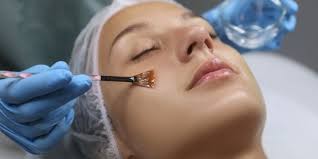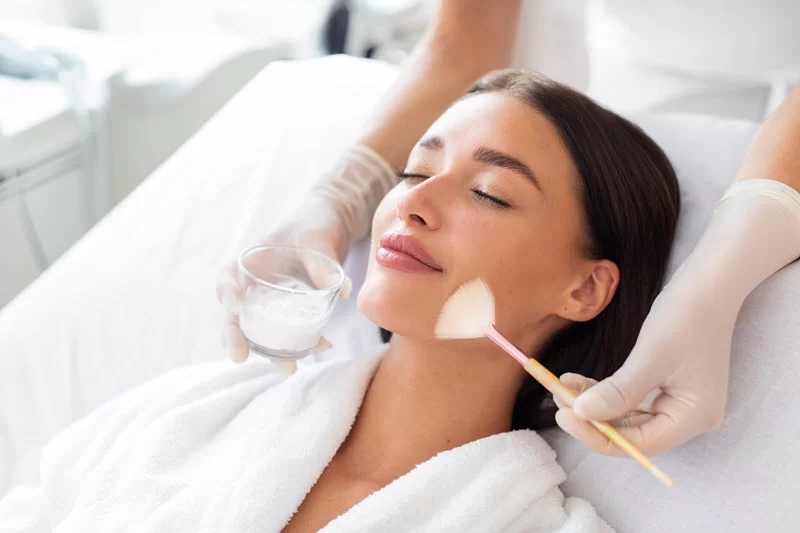Is a chemical peel good for ageing skin?
April 21, 2025
Contents
Is a chemical peel good for ageing skin?
Short answer: yes.
Long answer: it depends on your skin, but most people with ageing skin will see real results after a chemical peel.
If you’re starting to notice fine lines, rough patches, or uneven skin tone, a chemical peel might be just what your skin needs. It’s not magic – but it does work when done right. Let’s talk about how chemical peels help with ageing skin and what you can expect if you’re thinking about getting one.
What is a chemical peel, anyway?
A chemical peel is a skin treatment that uses a special solution (usually a mix of acids) to remove the top layers of your skin. Sounds intense, but it’s pretty straightforward.
The idea is simple: take off the dull, damaged layer so new, fresh skin can come through. Your skin naturally sheds dead skin cells every month, but as we get older, that process slows down. Chemical peels help speed it up again.
There are different types of peels – light, medium, and deep. Light peels are the most common and have little downtime. Deeper peels go further into the skin and give stronger results, but they need more healing time. Your skin type, concerns, and goals will help decide which one’s right for you.
How peels help ageing skin
As we age, skin starts to change. You might see fine lines around the eyes and mouth, your skin might feel rougher or drier, and you might notice dark spots or an uneven tone. Chemical peels work on all of that.
1. Fine lines and wrinkles
Chemical peels can’t erase deep wrinkles, but they do help soften the small lines that come with ageing. Especially the ones around your mouth, eyes, and forehead. When the outer layer of skin is removed, the body makes new skin cells and more collagen. That’s the stuff that keeps your skin firm and bouncy. More collagen = fewer lines over time.
Light peels and hydrafacials help with surface lines. Medium and deep peels can target deeper lines. But even regular light peels, done over time, can make your skin look smoother and younger.
2. Texture
As you get older, your skin might feel rough or bumpy in spots. This can be from sun damage, dry patches, or just slower skin turnover. Peels smooth that out by getting rid of dead skin and encouraging fresh cells to come forward.
After a chemical peel, most people say their skin feels softer, looks brighter, and has that “fresh-faced” look again. It’s not just about how it looks – it actually feels better to touch.

3. Uneven skin tone and dark spots
Sun exposure, age, and hormones can cause uneven tone and pigmentation – those brown spots or blotches that don’t fade easily. A chemical peel helps fade them by lifting off the layers where pigment builds up. It won’t fix all pigmentation in one go, but it’s a great tool for breaking it down over time.
If you’ve got sun damage, melasma, or dark marks from breakouts, a chemical peel can make a big difference. Consistent skin care treatments, paired with good skincare (and sunscreen!), can really even out your tone.
Bonus: Better product absorption
Once that top layer of dead skin is gone, your skincare products can actually do their job better. Serums, moisturisers, and treatments go deeper into the skin instead of just sitting on the surface.
So if you’ve been using a fancy anti-ageing cream and not seeing results – try pairing it with a peel. You might finally see what the cream is supposed to do.

What kind of peel is best for ageing skin?
That depends on your skin and what you want to fix. Here’s a quick breakdown:
Light peels: Good for freshening up skin, softening fine lines, and evening out skin tone. Little to no downtime. Great for beginners.
Medium peels: Go deeper. Help with deeper wrinkles, age spots, and rough texture. You might have a few days of redness or peeling.
Deep peels: Serious results, but more healing time. Usually only done once. Best for deep wrinkles and serious sun damage.
Most people start with light or medium peels and build from there. You don’t have to jump straight into the deep end.
How often should you get a peel?
For ageing skin, once a month is common for light peels. It gives your skin time to recover and keeps the benefits going. If you’re doing a medium peel, you might only do it every 3–6 months. Deep peels are usually a once-only deal.
Your esthetician or skincare therapist will help set up a schedule based on your skin goals.
Does it hurt? What’s recovery like?
Peels don’t usually hurt, but you might feel a little stinging or tingling during the treatment. Afterward, your skin might be pink or feel tight for a day or two. Then you might peel a little – think of it like a mild sunburn. Some people don’t peel at all, especially with lighter peels.
The key is to follow your aftercare:
No picking
Use sunscreen every day
Stay moisturised
Avoid harsh products while healing
If you follow the steps, you’ll heal up fast and see results quicker.
Who shouldn’t get a peel?
If you’ve got very sensitive skin, active eczema, or rosacea, you’ll want to be careful. Same goes if you’re pregnant, breastfeeding, or on certain medications like Accutane. Always check with your skincare pro before booking anything.
Also, if you’re out in the sun a lot and can’t avoid it, a peel might not be the best move right now. Your skin will be extra sun-sensitive afterward.
Is it worth it?
Yes, if you want smoother skin, fewer fine lines, better tone, and more glow without jumping straight to injectables or lasers, chemical peels are a solid choice. They’re simple, safe when done by pros, and give real results over time.
It’s not a one-time miracle, but with regular treatments, your skin can stay looking younger, longer.

Book your chemical peel today
A chemical peel is one of the easiest ways to freshen up ageing skin. It helps with fine lines, rough texture, and uneven skin tone. It can soften the signs of getting older and make your skin feel alive again.
You don’t need to go overboard. Even a light peel once a month can keep your skin looking and feeling better. Talk to a skincare professional who knows what they’re doing, and they’ll help you figure out the right kind of peel for you.
And don’t forget the sunscreen. It’s your skin’s best friend – before and after a peel.